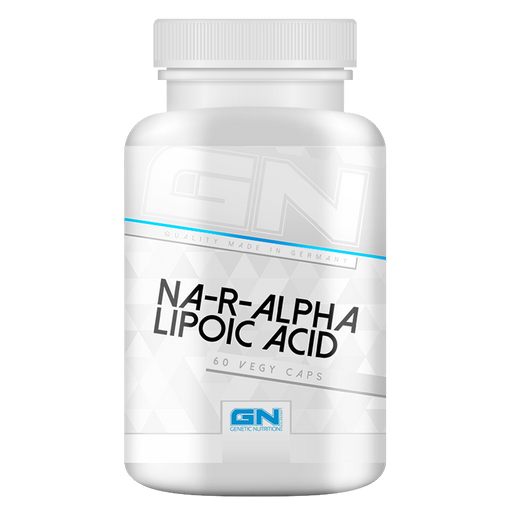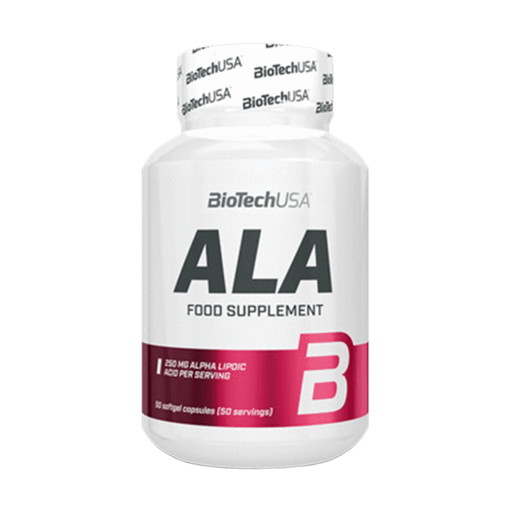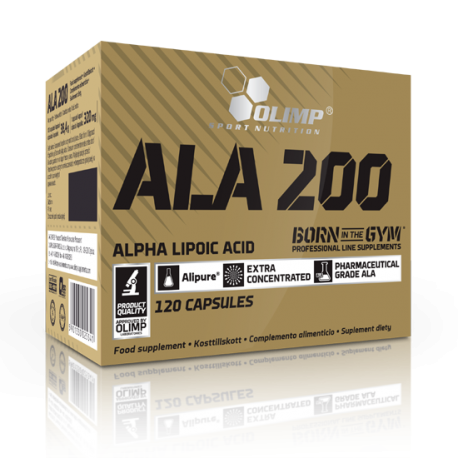Alpha-linolenic acid
-
 Save 78%
Save %
Original price €27,90Original price €27,90 - Original price €27,90Original price €27,90Current price €6,20€6,20 - €6,20Current price €6,20| /
Save 78%
Save %
Original price €27,90Original price €27,90 - Original price €27,90Original price €27,90Current price €6,20€6,20 - €6,20Current price €6,20| /NA-R-Alpha Lipoic Acid · 60 capsules
GN Laboratories9 reviewsAlpha lipoic acid in its most potent form for antioxidant protection, increased energy, faster post-workout recovery, healthy blood sugar levels an...
View full detailsOriginal price €27,90Original price €27,90 - Original price €27,90Original price €27,90Current price €6,20€6,20 - €6,20Current price €6,20| /Save 78% Save % -
 Save 0%
Save %
Original price €13,90 - Original price €13,90Original price €13,90€13,90€13,90 - €13,90Current price €13,90| /
Save 0%
Save %
Original price €13,90 - Original price €13,90Original price €13,90€13,90€13,90 - €13,90Current price €13,90| /ALA · 50 capsules
Biotech USANo reviewsAlpha lipoic acid is a vitamin-like antioxidant It dissolves in both fat and water and acts throughout the body A daily dose of 200-300 mg is reco...
View full detailsOriginal price €13,90 - Original price €13,90Original price €13,90€13,90€13,90 - €13,90Current price €13,90| /Save 0% Save % -
 Save 0%
Save %
Original price €29,90 - Original price €29,90Original price €29,90€29,90€29,90 - €29,90Current price €29,90| /
Save 0%
Save %
Original price €29,90 - Original price €29,90Original price €29,90€29,90€29,90 - €29,90Current price €29,90| /ALA 200 · 120 capsules
Olimp Sport Nutrition1 reviewFood supplement with alpha-lipoic acid Improvement of energy production Protection against the negative effects of oxidation Antioxidant effect Su...
View full detailsOriginal price €29,90 - Original price €29,90Original price €29,90€29,90€29,90 - €29,90Current price €29,90| /Save 0% Save %
Like linoleic acid,alpha-linolenic acid belongs to the group of polyunsaturated fatty acids. Both fatty acids are essential. According to their chemical structure, polyunsaturated fatty acids, such as those found in humans, are aliphatic monocarboxylic acids with a chain length of 18 to 22 carbon atoms and 2 to 6 double bonds. Polyunsaturated fatty acids are classified into 3 fatty acid families: omega-3, omega-6 and omega-9 fatty acids. These fatty acids are also commonly referred to as n-3, n-6 and n-9 fatty acids. The difference between the families lies in the position of the first double bond in the molecule. Alpha-linolenic acid is an n-3 fatty acid. The more highly unsaturated, longer-chain representatives of the n-3 series are formed endogenously from it by introducing a double bond (desaturation) and chain extension (elongation). The n-6 fatty acid series is derived from linoleic acid.
However, there is a bottleneck: the fatty acid families compete for the same enzyme system for the reaction steps. As a result, the amount of eicosapentaenoic acid (EPA), docosahexaenoic acid (DHA) and arachidonic acid (AA) formed depends strongly on the concentration of the starting fatty acids.
Alpha-linolenic acid, the new star among the fatty acids
Alpha-linolenic acid belongs to the n-3 fatty acids. Science has paid particular attention to these since n-3 fatty acids, especially EPA, were discovered in fish oil as a guarantee for the healthy hearts of the Eskimos. Because fish oil and fatty marine fish have not established themselves as sources of EPA in the diet, there is great interest in healthy alternatives in both science and practice.
ALA is interesting in two respects
- The positive effects known from EPA can be transferred to ALA because ALA is a direct precursor for EPA. Prerequisite: the conversion rate in humans must be sufficiently high.
- ALA itself appears to exert positive effects in the metabolism that are independent of the conversion to EPA.
Several intervention studies show that long-chain n-3 fatty acids, especially EPA, protect against heart attacks (Burr, 1989; De Lorgeril, 1999; GISSI-investigators, 1999). The positive effect is explained by the eicosanoids formed from EPA. The GISSI study with a total of over 11,000 patients who had suffered a heart attack showed that supplementation of EPA and DHA over 3 to 5 years significantly reduced mortality from heart attacks and also overall mortality compared to a normal diet. The human organism also appears to fulfill the requirement that ALA is converted to EPA. Up to 10 % of the essential fatty acids supplied are converted into the corresponding longer-chain derivatives in the human organism under normal nutritional conditions (Demmelmair, Koletzko 1999).
It can be assumed that in humans 6% of the amount of ALA ingested is converted to EPA and 3.8% to DHA. However, if the diet is rich in n-6 fatty acids, especially linoleic acid, the conversion of ALA to EPA can be reduced to 40 to 50 % (Gerster, 1998; Valsta, 1996). The background: for the endogenous synthesis of EPA and DHA from ALA, these n-3 fatty acids compete with the fatty acids of the n-6 family for a common enzyme system. Sufficient EPA and DHA can only be formed if there is not too much linoleic acid present. This suggests a ratio of n-6 to n-3 fatty acids of at least 5:1.
There is also evidence that ALA can protect against heart attacks
The Lyon study impressively demonstrated that a Mediterranean diet rich in oleic acid and ALA significantly reduces the rate of reinfarction and overall mortality in patients after a heart attack. A comparison was made with a diet rich in linoleic acid. The decisive factor for the positive effect was the high proportion of rapeseed oil. The ratio of LA to ALA was around 4:1 (de Lorgeril, 1999). Other important observations support the assumption of the independent effect of ALA. Various observational studies have shown that the higher the intake of ALA, the lower the incidence of sudden cardiac death (Ascherio, 1996; Dolecek, 1992; Hu, 1999; Pietinen, 1997). It has also been observed that the risk of stroke is reduced as the proportion of ALA in the diet increases. An increasing ALA content of cholesterol and phospholipids has been discussed as a possible mode of action (Dolecek, 1992). Research into the mechanisms of action of ALA against cardiovascular diseases is still in its infancy.
There are various indications that the effect of ALA on the coronary arteries differs from the effect of EPA or DHA. As a conclusion from these and other study data, the new D-A-CH reference values recommend increasing the intake of ALA from a preventive perspective and at the same time limiting the intake of linoleic acid. In line with the recommendations in Canada and Australia, LA and ALA should be in a ratio of up to 5:1. In fact, a ratio of 10:1 to 7:1 has been achieved to date under normal dietary habits. In practice, the question arises as to how the new findings can be implemented in daily nutritional practice.
One interesting use of ALS for weight training would be to improve the insulin sensitivity of the muscles. By stimulating the so-called Glut1 and Glut4 glucose transporters, both insulin-dependent and insulin-independent carbohydrate uptake in the muscles is increased. In studies with diabetics, a reduction in insulin requirements was observed with ALS supplementation. It is quite conceivable that even healthy people can improve their insulin sensitivity by taking ALS.
This can at least be concluded from the experience reports of athletes who have tried this substance. They report a significantly improved pump during training and fuller muscles. An improvement in insulin sensitivity also optimizes the transport of amino acids into the muscle cells, so that anabolic processes are promoted. Creatine uptake into the muscles, which is largely insulin-dependent, is also improved.
Demand in sport
An interesting use of ALS for weight training would be to improve the insulin sensitivity of the muscles. By stimulating the so-called Glut1 and Glut4 glucose transporters, both insulin-dependent and insulin-independent carbohydrate uptake into the muscles is increased. In studies with diabetics, a reduction in insulin requirements was observed with ALS supplementation. It is quite conceivable that even healthy people can improve their insulin sensitivity by taking ALS. This can at least be concluded from the experience reports of athletes who have tried this substance.
They report a significantly improved pump during training and fuller muscles. An improvement in insulin sensitivity also optimizes the transport of amino acids into the muscle cells, so that anabolic processes are promoted. Creatine uptake into the muscles, which is largely insulin-dependent, is also improved. As ALS is rapidly absorbed by the body, it is recommended that the dosages are divided into several individual doses per day. 50-400mg per day is sufficient to utilize the antioxidant effects of this substance. To improve insulin sensitivity, 600-1200mg per day is necessary.
Safety and side effects
Alpha-linolenic acid is probably safe and harmless for most adults when used in the amounts found in food. There is not enough information to make a statement about the safety and harmlessness of higher amounts. Alpha-linolenic acid from food sources is very well tolerated.
Precautions and warnings
Pregnancy and lactation: Alpha-linolenic acid is probably safe and harmless during pregnancy and lactation at normal dietary levels. However, not enough is known about the safety and harmlessness of higher amounts during pregnancy and breastfeeding, so pregnant and breastfeeding women should avoid using alpha-linolenic acid supplements to be on the safe side.
High triglyceride levels in the blood: Alpha-linolenic acid should not be used if you suffer from high triglyceride levels, as alpha-linolenic acid could further worsen these blood values.
Prostate cancer: You should not use alpha-linolenic acid supplements if you suffer from prostate cancer or have an increased family risk of prostate cancer. There is evidence that alpha-linolenic acid may increase the risk of prostate cancer.
References
- Packer L. Oxidants, antioxidant nutrients and the athlete. J Sports Sci 1997 Jun;15(3):353-63 [abstract]
- Sen CK. Antioxidants in exercise nutrition. Sports Med 2001;31(13):891-908 [abstract]
- Teichert J, Kern J, Tritschler HJ, Ulrich H, Preiss R. Investigations on the pharmacokinetics of alpha-lipoic acid in healthy volunteers. Int J Clin Pharmacol Ther 1998 Dec;36(12):625-8 [abstract]
- Jones W, Li X, Qu ZC, Perriott L, Whitesell RR, May JM. Uptake, recycling, and antioxidant actions of alpha-lipoic acid in endothelial cells. Free Radic Biol Med 2002 Jul 1;33(1):83-93
- Gonzalez-Perez O, Gonzalez-Castaneda RE, Huerta M, Luquin S, Gomez-Pinedo U, Sanchez-Almaraz E, Navarro-Ruiz A, Garcia-Estrada J. Beneficial effects of alpha-lipoic acid plus vitamin E on neurological deficit, reactive gliosis and neuronal remodeling in the penumbra of the ischemic rat brain. Neurosci Lett 2002 Mar 15;321(1-2):100-4
- Lu C, Liu Y. Interactions of lipoic acid radical cations with vitamins C and E analog and hydroxycinnamic acid derivatives. Arch Biochem Biophys 2002 Oct 1;406(1):78-84
- Hultberg B, Andersson A, Isaksson A. Lipoic acid increases glutathione production and enhances the effect of mercury in human cell lines. Toxicology 2002 Jun 14;175(1-3):103-10
- Sen CK, Packer L. Thiol homeostasis and supplements in physical exercise. Am J Clin Nutr 2000 Aug;72(2 Suppl):653S-69S
- Khanna S, Atalay M, Laaksonen DE, Gul M, Roy S, Sen CK. Alpha-lipoic acid supplementation: tissue glutathione homeostasis at rest and after exercise. J Appl Physiol 1999 Apr;86(4):1191-6
- Ruhe RC, McDonald RB. Use of antioxidant nutrients in the prevention and treatment of type 2 diabetes. J Am Coll Nutr 2001 Oct;20(5 Suppl):363S-369S; discussion 381S-383S [abstract]
- Greene EL, Nelson BA, Robinson KA, Buse MG. Alpha-lipoic acid prevents the development of glucose-induced insulin resistance in 3T3-L1 adipocytes and accelerates the decline in immunoreactive insulin during cell incubation. Metabolism 2001 Sep;50(9):1063-9
- El Midaoui A, de Champlain J. Prevention of hypertension, insulin resistance, and oxidative stress by alpha-lipoic acid. Hypertension 2002 Feb;39(2):303-7
- Saengsirisuwan V, Kinnick TR, Schmit MB, Henriksen EJ. Interactions of exercise training and lipoic acid on skeletal muscle glucose transport in obese Zucker rats. J Appl Physiol 2001 Jul;91(1):145-53
- Hallsten K, Yki-Jarvinen H, Peltoniemi P, Oikonen V, Takala T, Kemppainen J, Laine H, Bergman J, Bolli GB, Knuuti J, Nuutila P. Insulin- and exercise-stimulated skeletal muscle blood flow and glucose uptake in obese men. Obes Res 2003 Feb;11(2):257-65 [abstract]
- Arrowsmith FE, Ward J, Rooney K, Kriketos AD, Baur LA, Thompson CH. Body fatness, insulin sensitivity and muscle oxygen supply in adolescents. Clin Sci (Lond) 2002 Oct;103(4):391-6
- van Haperen R, de Waard M, van Deel E, Mees B, Kutryk M, van Aken T, Hamming J, Grosveld F, Duncker DJ, de Crom R. Reduction of blood pressure, plasma cholesterol, and atherosclerosis by elevated endothelial nitric oxide. J Biol Chem 2002 Dec 13;277(50):48803-7
- Chamruspollert M, Pesti GM, Bakalli RI. Dietary interrelationships among arginine, methionine, and lysine in young broiler chicks. Br J Nutr 2002 Dec;88(6):655-60 [abstract]
- Visioli F, Smith A, Zhang W, Keaney JF Jr, Hagen T, Frei B. Lipoic acid and vitamin C potentiate nitric oxide synthesis in human aortic endothelial cells independently of cellular glutathione status. Redox Rep 2002;7(4):223-7 [abstract]
- Flier J, Van Muiswinkel FL, Jongenelen CA, Drukarch B. The neuroprotective antioxidant alpha-lipoic acid induces detoxication enzymes in cultured astroglial cells. Free Radic Res 2002 Jun;36(6):695-9 [abstract]
- Farr SA, Poon HF, Dogrukol-Ak D, Drake J, Banks WA, Eyerman E, Butterfield DA, Morley JE. The antioxidants alpha-lipoic acid and N-acetylcysteine reverse memory impairment and brain oxidative stress in aged SAMP8 mice. J Neurochem 2003 Mar;84(5):1173-83
- Ametov AS, Barinov A, Dyck PJ, Hermann R, Kozlova N, Litchy WJ, Low PA, Nehrdich D, Novosadova M, O'Brien PC, Reljanovic M, Samigullin R, Schuette K, Strokov I, Tritschler HJ, Wessel K, Yakhno N, Ziegler D; SYDNEY Trial Study Group. The sensory symptoms of diabetic polyneuropathy are improved with alpha-lipoic acid: the SYDNEY trial. Diabetes Care 2003 Mar;26(3):770-6 [abstract]
- Liu J, Head E, Gharib AM, Yuan W, Ingersoll RT, Hagen TM, Cotman CW, Ames BN. Memory loss in old rats is associated with brain mitochondrial decay and RNA/DNA oxidation: partial reversal by feeding acetyl-L-carnitine and/or R-alpha -lipoic acid. Proc Natl Acad Sci U S A 2002 Feb 19;99(4):2356-61
- Gasic-Milenkovic J, Loske C, Munch G. Advanced glycation endproducts cause lipid peroxidation in the human neuronal cell line SH-SY5Y. J Alzheimers Dis 2003 Feb;5(1):25-30 [abstract]
- Reber F, Geffarth R, Kasper M, Reichenbach A, Schleicher ED, Siegner A, Funk RD. Graded sensitiveness of the various retinal neuron populations on the glyoxal-mediated formation of advanced glycation end products and ways of protection. Graefes Arch Clin Exp Ophthalmol 2003 Mar;241(3):213-25
- Ishibashi T, Murata T, Hangai M, Nagai R, Horiuchi S, Lopez PF, Hinton DR, Ryan SJ. Advanced glycation end products in age-related macular degeneration. Arch Ophthalmol 1998 Dec;116(12):1629-32 [abstract]
- Chidlow G, Schmidt KG, Wood JP, Melena J, Osborne NN. Alpha-lipoic acid protects the retina against ischemia-reperfusion. Neuropharmacology 2002 Nov;43(6):1015-25
- Baydas G, Yilmaz O, Celik S, Yasar A, Gursu MF. Effects of certain micronutrients and melatonin on plasma lipid, lipid peroxidation, and homocysteine levels in rats. Arch Med Res 2002 Nov-Dec;33(6):515-9 [abstract]
- Streeper RS, Henriksen EJ, Jacob S, Hokama JY, Fogt DL, Tritschler HJ. Differential effects of lipoic acid stereoisomers on glucose metabolism in insulin-resistant skeletal muscle. Am J Physiol 1997 Jul;273(1 Pt 1):E185-91 [abstract]
- Maitra I, Serbinova E, Tritschler HJ, Packer L. Stereospecific effects of R-lipoic acid on buthionine sulfoximine-induced cataract formation in newborn rats. Biochem Biophys Res Commun 1996 Apr 16;221(2):422-9
- Lockhart B, Jones C, Cuisinier C, Villain N, Peyroulan D, Lestage P. Inhibition of L-homocysteic acid and buthionine sulphoximine-mediated neurotoxicity in rat embryonic neuronal cultures with alpha-lipoic acid enantiomers. Brain Res 2000 Feb 14;855(2):292-7



